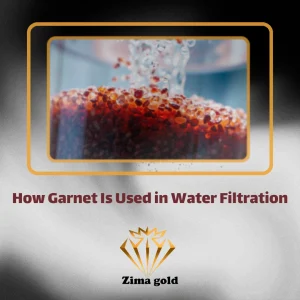How Garnet Is Used in Water Filtration
Water purification is a vital step in supplying clean water for domestic, industrial, and municipal use. In modern treatment systems, multi-layer filtration is commonly used to remove suspended particles, turbidity, and physical impurities. One of the most important materials used in the bottom layer of these filters is garnet.
Due to its high density, physical durability, and particle absorption efficiency, garnet is one of the best options for improving filtration performance. In this article, you’ll learn how to use this natural mineral correctly in the water treatment process.
What Is Garnet and Why Is It Suitable for Water Filtration?
Garnet is a natural, hard mineral that is crushed and graded to be used as a high-performance granular filter media in water treatment systems. It has a high specific gravity (around 4.2–4.5 g/cm³) and is known for its ability to serve as an effective bottom filtration layer.
Key features of garnet for filtration use:
-
Excellent capability to capture fine suspended particles
-
High resistance to abrasion and chemicals
-
Reusable and washable through backwash cycles
-
Longer lifespan compared to silica or standard sand

How Garnet Is Used in Multi-Media Filters
🌊 Typical Structure of Multi-Layer Filters
These filters use several layers of different densities and grain sizes to efficiently trap particles of varying sizes.
Common filter layout (top to bottom):
-
Anthracite or activated carbon – traps coarse particles and organic matter
-
Silica sand (coarse and fine) – captures medium-sized particles
-
Garnet – the bottom layer that captures fine particles and stabilizes the bed
⚙️ Installation Process:
-
Select the appropriate mesh size
Common options: mesh 20/40, 30/60, or 60/100 depending on the application. -
Pre-wash the garnet media
To remove dust or impurities before loading into the filter tank. -
Layering from coarse to fine
Garnet must be placed as the bottom layer to effectively trap the smallest particles. -
Backwashing at proper intervals
After each filtration cycle, perform a backwash to restore garnet performance and remove trapped contaminants.
Applications of Garnet in Water Treatment
| Application | Description |
|---|---|
| Municipal water treatment | Improves water clarity, reduces suspended solids (TSS) |
| Industrial water purification | Used in cooling towers, boilers, and process systems |
| Wastewater treatment | Acts as a pre-treatment before RO or disinfection |
| Pools and spas | Enhances water quality and reduces chemical use |
| Agricultural water | Prevents clogging in irrigation systems |
Advantages of Garnet over Other Filter Media
-
✅ High density → better depth filtration
-
✅ Uniform grains → even flow distribution
-
✅ Chemical and acid resistant
-
✅ Reusable and cost-effective long term
-
✅ Improves total filtration efficiency
Frequently Asked Questions (FAQ)
❓ Is garnet safe for drinking water filtration?
✅ Yes. If it is of high purity and certified for potable water use, garnet is completely safe.
❓ How often should garnet be replaced?
✅ Typically every 3 to 5 years, depending on water quality and frequency of backwashing.
❓ What particle sizes can garnet remove?
✅ Garnet can trap particles as small as 10 microns or finer, depending on the mesh used.
❓ Can garnet replace silica in filters?
✅ No, it complements silica. Garnet is used in the bottom layer while silica sand remains in the middle layers.
Conclusion
Garnet is a natural, efficient, and durable material used in water filtration systems. As the base layer in multi-media filters, it plays a vital role in removing fine particles and improving final water quality. By selecting the right mesh size and maintaining proper use, garnet becomes an economical and long-lasting choice in water treatment operations.

